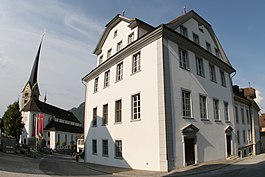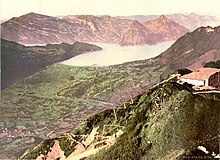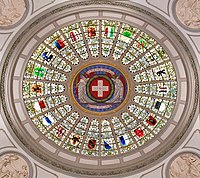Stans
Stans | |
|---|---|
 | |
| Coordinates:46°57′N8°21′E/ 46.950°N 8.350°E | |
| Country | Switzerland |
| Canton | Nidwalden |
| District | n.a. |
| Government | |
| •Mayor | Gemeindepräsidentin Beatrice Richard-RufFDP/PRD |
| Area | |
| • Total | 11.08 km2(4.28 sq mi) |
| Elevation | 452 m (1,483 ft) |
| Population (31 December 2018)[2] | |
| • Total | 8,393 |
| • Density | 760/km2(2,000/sq mi) |
| Time zone | UTC+01:00(Central European Time) |
| • Summer (DST) | UTC+02:00(Central European Summer Time) |
| Postal code(s) | 6370 |
| SFOS number | 1509 |
| ISO 3166 code | CH-NW |
| Surrounded by | Buochs,Dallenwil,Ennetbürgen,Ennetmoos,Oberdorf,Stansstad |
| Website | www SFSO statistics |
Stans(German pronunciation:[ʃtans]) is the capital of thecantonofNidwalden(Nidwald) in Switzerland.
The official language of Stans isGerman(spoken there in the variety ofSwiss Standard German), but the main language is the local variant ofAlemannicSwiss German.
History[edit]

Stans is one of the oldest settlements in the entire Nidwalden valley. The first traces of human settlement date to the second century BC.[3]During theRomanera there is little evidence of a settlement except for someGallo-RomanUstrinumorfuneral pyresand theLatinroot (stagnummeaning a pool or sump) of the name Stans.[3]
During the seventh or eighth century, theAlamannisettled in the region. TheChristianAlamanni built the first church in Stans around 750 AD. This pre-Carolingianchurch served as theparishchurch for the entireEngelbergValley. The church was expanded numerous times until it was finally replaced in 1647 by the new church of St. Peter and Paul.[3]
Stans was first mentioned in 1124.[4]By 1291, whenUnterwaldenjoinedUriandSchwyzin what became the Swiss Confederation, Stans was already the capital of the section known asUnterwalden nid dem Kernwaldwhich would become the half canton of Nidwalden.
In 1386, during theBattle of Sempach,a soldier from Stans,Arnold von Winkelried,is claimed to have thrown himself on thepikesof theHabsburgarmy which led the Swiss to victory. However it is doubtful whether he existed or died in the battle as the first mention of his selfless act appears over 150 years after the battle and a man who may have been Arnold was party to a lawsuit in 1389. Regardless, the legend is firmly in place in Stans, with a monument and his house located in the town.
Following the Swiss victories in theBurgundian WarstheOld Swiss Confederationwas nearly torn apart by internal conflict when the city cantons insisted on having the lion's share of the proceeds since they had supplied the most troops. The country cantons resented this and theTagsatzungor leadership of each of the cantons met in Stans in 1481 to resolve the issues. However, they were unable to resolve the issues and war seemed inevitable. A local hermit,Niklaus von der Flüe,was consulted on the situation. He requested that a message be passed on to the members of theTagsatzungon his behalf. The details of the message have remained unknown to this day, however it did calm the tempers and led to the drawing up of theStanser Verkommnis.As part of theVerkommnisFribourgandSolothurnwere admitted into the confederation.
During theMiddle Ages,Stans was protected with seven towers. However, the town never built a wall to connect the towers and encircle it.[3]


In 1713 two-thirds of the town was destroyed in a fire. Following the fire, new regulations kept the village square (Dorfplatz) open and clear of construction. The large, open square surrounded bybaroquehouses and the town council house (Rathaus) owe their appearance to the fire and subsequent reconstruction.

In 1798 Stans was stormed by French troops, following the decision of Nidwalden not to adopt the constitution of theHelvetic Republic.Children orphaned by this event were gathered by the educatorJohann Heinrich Pestalozzifor his first school. He converted theConventofSt. Klara(built in 1621–1625) into a school for the children.[4]However, he only had the school until the following year when the French Army needed the building and the orphan's school came to a sudden end.[5]In 1814, following the collapse of the NapoleonicAct of Mediation,Nidwalden attempted to return to theAncien Regimegovernment, with subject lands belonging to the canton. Stans and the rest of Nidwalden only gave up their subject lands when Federal troops marched into the city.[6]Stans and the rest of Nidwalden joined theSonderbundin 1845 and were involved in the 1847 Sonderbund War.
In the 20th century, modern technology and transportation changed Stans. In 1893 Stans was connected to the rail network of Lucerne by steam ferry. In 1964 the Lucerne-Stans-Engelberg rail way was opened and in 1966 theA2 motorway(which is Switzerland's main north–south axis fromBaseltoChiasso) was constructed.
The open-air assembly (Landsgemeinde) was held in Stans annually until its abolition in 1997.
Geography[edit]


The area of Stans is 11.08 km2(4.28 sq mi). Much of the land within the borders of Stans is agricultural (43.7%), while just over a third (36.5%) is forested. Of the remaining area, about 17% is settlements and less than 2.6% is unproductive (mountains, rivers or glaciers).[7]The highest point within the borders of Stans is on theStanserhornand is 1,819 m (5,968 ft) above sea level. The lowest point is atFronhofenwhere the elevation is 438 m (1,437 ft). The village square (Dorfplatz) has an elevation of 452 m (1,483 ft).[8]
Climate[edit]
Stans has an average of 137.7 days of rain per year and on average receives 1,224 mm (48.2 in) of precipitation. The wettest month is August when Stans receives an average of 166 mm (6.5 in) of precipitation on 13.6 days. The month with the most days of precipitation is June, with an average of 14.2, but with only 156 mm (6.1 in) of precipitation. The driest month of the year is January with an average of 65 mm (2.6 in) of precipitation over 13.6 days.[9]
Demographics[edit]
Stans has a population (as of 31 December 2020) of 8,171.[10]As of 2007[update],9.4% of the population was made up of foreign nationals.[11]Over the last 10 years the population has grown at a rate of 13.2%. Most of the population (as of 2000[update]) speaks German (91.6%), with Italian being second most common (2.0%) and Serbo-Croatian being third (1.2%).[12]As of 2008[update]the gender distribution of the population was 48.6% male and 51.4% female. As of 2000[update]there are 2,816 households, of which 1,837 households (or about 65.2%) contain only one or two individuals. 202 or about 7.2% are large households, with at least five members.[13]
In the2007 federal electionthe most popular party was theFDPwhich received 88% of the vote. Most of the rest of the votes were given to local small right-wing parties (10.8%).[12]
In Stans about 75.2% of the population (between age 25–64) have completed either non-mandatoryupper secondary educationor additional higher education (either university or aFachhochschule).[12]
The historical population is given in the following table:[8][13]
| Year | Inhabitants | Swiss | Foreign |
|---|---|---|---|
| 1970 | 5,445 | 5,022 | 423 |
| 1980 | 5,660 | 5,340 | 320 |
| 1990 | 6,171 | 5,697 | 474 |
| 1995 | 6,468 | 5,896 | 572 |
| 2000 | 6,914 | 6,349 | 665 |
| 2005 | 7,512 | 6,875 | 637 |
| 2006 | 7,556 | 6,936 | 620 |
| 2007 | 7,577 | 6,909 | 668 |
| 2008 | 7,784 | 7,050 | 734 |
Industry[edit]
Stans has an unemployment rate of 1.27%. As of 2005[update],there were 89 people (1.2%) employed in theprimary economic sectorand about 32 businesses involved in this sector. 2,463 people (34%) are employed in thesecondary sectorand there are 113 businesses in this sector. 4,601 people (65%) are employed in thetertiary sector,with 496 businesses in this sector.[7][12]
Transport[edit]
Stans is served byStans stationon theLuzern–Stans–Engelberg line.Lucerne S-BahnS4service provides two trains per hour to and fromLucerne,and the hourlyInterRegioservice between Lucerne and Engelberg also stops in Stans.[14]
Sights[edit]
Stanserhorn[edit]

The local mountain, theStanserhorn(1,898 m (6,227 ft)) is also a tourist resort. It is accessible via one of the oldest mountain railways in Switzerland, theStanserhornbahn(1893), and by cable car. TheStanserhornbahnwas originally built as arack and pinionrailway, with three separate sections. In 1970 the upper section was destroyed by a fire following a lightning strike. In 1975 the destroyed upper section and the middle section were replaced by an aerial cable car. At the peak of the Stanserhorn is theRondorama,a revolving restaurant that was built in 2001. From the peak of the Stanserhorn, on a clear day the view stretches nearly 100 km (62 mi) and includes 10 Swiss lakes and theBlack Forestof Germany.[15]There is a short hiking trail around the peak of the Stanserhorn and a small population ofMarmotsare kept near the trail.[16]

Dorfplatz[edit]
Following the fire in 1713, the village square (Dorfplatz) was fully rebuilt, to its current unified appearance, in 1715 according to a plan by Josef Aebi and Ludwig Gassmann. The square now houses theWinkelriedfountain and the sculptureDer Tod und das Mädchen(Death and the Maiden). TheWinkelriedmonument was carved fromCarrarainmarblein Rome and then shipped by boat, rail and horse team to Stans in 1865.[17]The monument is in aGothic Revivalstyle and was carved by Ferdinand Schlöth. Death and the Maiden was done by Rudolf Brem.[18]
Parish church[edit]
The Parish church,St. Peter und Paulwas built from 1641 until 1647 by the architect Jakob Berger. The church was constructed in an early-Baroquestyle, while the bell tower is an olderRomanesquestructure. The threenaveBasilicawas built south of the earlier church, though the older bell tower dates from this previous church.[4]The interior is decorated in white, gold and black. The simple interior ornamentation comes fromLombardywhile there altar figures were done by Georg Allhelg.[18]Next to the church is a two-story chapel andossuaryfor the nearby Capuchin monastery.
Capuchin monastery[edit]

ACapuchin monasterywas established in Stans in 1583 byMelchior Lussy,who had been sent to theCouncil of Trent.Initially there was resistance to the poverty, simple habits and beards of this order ofCounter-Reformationmonks.[17]In 1777 the monks opened a Latin school, which was suppressed from 1798 until 1803 under the Helvetic Republic. TheKollegium St. Fideliswas built by the monks in 1895 and purchased by the canton in 1988. The monastery church was built in 1683 and renovated in 1980.[18]In 1956 a memorial tablet to Melchoir Lussy was placed near the gate of the monastery.
Convent St. Klara[edit]

The Convent St. Klara was founded by Katharina and Maria Gut in 1618.[17]The buildings were built from 1621 to 1625.[4]In 1799 Heinrich Pestalozzi established his orphanage and school in the convent buildings. The convent church (built in 1723) is a simple structure with an ornatealtarby Johann Ritz and a mystical altar painting by Johannes Brandenburg. The church was renovated in 1980.[18]From the convent cemetery a path leads to the nearby Capuchin monastery.
Winkelriedhaus[edit]

A portion of theWinkelriedhaus(Winkelried House) was once home to the Winkelried family, though Arnold von Winkelried (if he existed) did not live in it.[17]The oldest part of the structure dates from the middle of the 15th century. The early house was an unusually tall and largehalf timbered(German:fachwerk,Alemannic German:Riegelbau) building, which was known throughout much of central Switzerland.[18]However, it was not owned by the Winkelrieds for very long; in 1541 the Lussy family purchased the house. Under Melchior Lussy the Gothic building was renovated over a period of 50 years into a much larger, Renaissance mansion. In 1766 theLandammann(Chief Magistrate) Jost Remigi Trachsler bought the house. During much of the second half of the 18th century he had theWinkelriedhausrenovated and added a number ofrococofrescoson the walls of the house. In 1815, the Kayser family bought the house, which they held until 1974 when it was given to the canton. It was restored from 1983 until 1991 and since then has been the home of theMuseum für Kultur und Brauchtum.[19]
Salzmagazin[edit]
TheSalzmagazin(lit. Salt storage house) was originally built to store grain and salt for the community in 1700. It has had many other uses since then including; a theater, a secondary school and finally a museum. The coat of arms of the builder and Landammann Nicolaus Keiser as well as two lions with the Nidwalden shield and two-header eagle are visible on the north gable.[20]
Statue of Deschwanden[edit]
In the front garden of the former Nidwaldner Kantonalbank is a monument by the Swiss sculptor August Stanser Blaesi (1903–1979) that was erected in memory of the local artistMelchior Paul von Deschwanden(1811–1881) in the autumn of 1933. Deschwanden was one of the most influential and productive religious painters of his time, trained in the Nazarene-style in Munich, Germany, who sent paintings to hang in Roman Catholic churches as far as Annapolis, Maryland and Covington, Kentucky. Amongst his pupils were Adalbert Baggenstos (1863–1897) from Stans, and the Swiss-born American portrait painterAdolfo Müller-Ury,in whose arms he died in February 1881.
Notable people[edit]
- Melchior Lussy(1529 in Stans – 1606), a Swiss Catholic statesman.[21]
- Melchior Paul von Deschwanden(1811 in Stans – 1881), religious painter
- Gustave Lussi(1898 in Stans – 1993), figure skating coach
- Hans von Matt(1899–1985), painter and sculptor, born and died in Stans
- Peter von Matt(born 1937), philologist and author, brought up in Stans
- Urs Odermatt(born 1955 in Stans), film director and author[22]
- Monika Hess(born 1964 in Stans), former alpine skier who competed in the1984 Winter Olympics
- Bruno Amstad(born 1964 in Stans), singer in the field of improvisation and jazz
- Joseph Odermatt(born ca.1965 in Stans), pope of thePalmarian Catholic Church
- Rochus Lussi(born 1965 in Stans), artist and art teacher and an independent sculptor in woodwork
- Seppi Hurschler(born 1983 in Stans), Nordic combined skier who has competed in three Winter Olympics
- Nicole Riner(born 1990 in Stans), retired tennis player
- Ayla Huser(born 1992 in Stans), badminton player
- Zoël Amberg(born 1992 in Stans), professional racing driver
References[edit]
- ^ab"Arealstatistik Standard - Gemeinden nach 4 Hauptbereichen".Federal Statistical Office.Retrieved13 January2019.
- ^https:// pxweb.bfs.admin.ch/pxweb/fr/px-x-0102020000_201/-/px-x-0102020000_201.px.Retrieved2 June2020.
{{cite web}}:Missing or empty|title=(help) - ^abcdStans Online-History(in German)accessed 21 May 2009
- ^abcdFlüeler (1982).Kulturführer Schweiz.Zurich, CH: Ex Libris Verlag AG. pp. 365–367.(in German)
- ^Schwickerath, Robert (1911)..Catholic Encyclopedia.Vol. 11.
- ^Sowerby, J. (1892).The forest cantons of Switzerland: Lucerne, Schwyz, Uri, Unterwalden.Percival & Co. p.36.Retrieved2009-05-21.
The Forest Cantons of Switzerland.
- ^abSwiss Federal Statistical Officeaccessed 18 May 2009
- ^abStans City website-Numbers(in German)accessed 22 May 2009
- ^"Temperature and Precipitation Average Values-Table, 1961-1990"(in German, French, and Italian). Federal Office of Meteorology and Climatology - MeteoSwiss. Archived fromthe originalon 27 June 2009.Retrieved8 May2009.,the weather station elevation is 438 meters above sea level.
- ^"Ständige und nichtständige Wohnbevölkerung nach institutionellen Gliederungen, Geburtsort und Staatsangehörigkeit".bfs.admin.ch(in German). Swiss Federal Statistical Office - STAT-TAB. 31 December 2020.Retrieved21 September2021.
- ^Nidwalden Statistical Office-Population(in German)accessed 4 September 2009
- ^abcdSwiss Federal Statistical Officeaccessed 04-Sep-2009
- ^abNidwalden Statistical Office-Municipalities(in German)accessed 4 September 2009
- ^"Luzern–Stans–Engelberg"(PDF).Bundesamt für Verkehr.Retrieved2013-01-14.
- ^Description of the Rondoramaaccessed 22 May 2009
- ^Stanserhorn - What to doaccessed 22 May 2009
- ^abcdStans City website-Cultural-historic tour by Ursula Flüeler(in German)accessed 26 May 2009
- ^abcdeStans City website-Historic toursaccessed 26 May 2009(in German)
- ^Nidwalder Museums-Winkelriedhaus(in German)accessed 27 May 2009
- ^Nidwalder Museums-Salzmagazin(in German)accessed 27 May 2009
- ^Meyer, Johann Georg(1910)..Catholic Encyclopedia.Vol. 9.
- ^IMDb Databaseretrieved 05 March 2019
External links[edit]
- Official Page(in German)
- Coolidge, William Augustus Brevoort(1911)..Encyclopædia Britannica.Vol. 25 (11th ed.). pp. 782–783.






